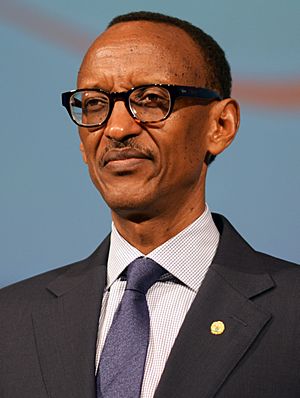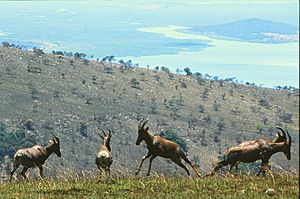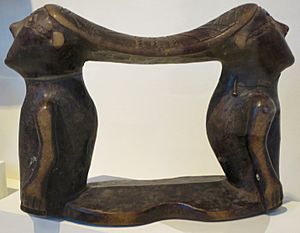Rwanda facts for kids
Quick facts for kids
Republic of Rwanda
|
|
|---|---|
|
|
|
|
Motto: "Ubumwe, Umurimo, Gukunda Igihugu"
(English: "Unity, Work, Patriotism") (French: "Unité, Travail, Patriotisme") (Swahili: "Umoja, Kazi, Uzalendo") |
|
|
Anthem: "Rwanda Nziza"
(English: "Beautiful Rwanda") |
|

Location of Rwanda (dark blue)
in Africa (light blue) |
|
| Capital and largest city
|
Kigali 1°56′38″S 30°3′34″E / 1.94389°S 30.05944°E |
| Official languages |
|
| Ethnic groups
(1994)
|
|
| Religion |
|
| Demonym(s) |
|
| Government | Unitary presidential republic under an authoritarian dictatorship |
| Paul Kagame | |
| Édouard Ngirente | |
| Legislature | Parliament |
| Senate | |
| Chamber of Deputies | |
| Formation | |
|
• Kingdom of Rwanda
|
15th century |
|
• Part of German East Africa
|
1897–1916 |
|
• Part of Ruanda-Urundi
|
1916–1962 |
|
• Rwandan Revolution
|
1959–1961 |
|
• Republic declared
|
1 July 1961 |
|
• Independence from Belgium
|
1 July 1962 |
|
• Admitted to the UN
|
18 September 1962 |
|
• Current constitution
|
26 May 2003 |
| Area | |
|
• Total
|
26,338 km2 (10,169 sq mi) (144th) |
|
• Water (%)
|
6.341 |
| Population | |
|
• 2024 estimate
|
13,623,302 (76th) |
|
• Density
|
517/km2 (1,339.0/sq mi) (22nd) |
| GDP (PPP) | 2023 estimate |
|
• Total
|
|
|
• Per capita
|
|
| GDP (nominal) | 2023 estimate |
|
• Total
|
|
|
• Per capita
|
|
| Gini (2016) | 43.7 medium |
| HDI (2022) | low · 161st |
| Currency | Rwandan franc (RWF) |
| Time zone | UTC+2 (CAT) |
| Date format | dd/mm/yyyy |
| Driving side | right |
| Calling code | +250 |
| ISO 3166 code | RW |
| Internet TLD | .rw |
Rwanda, officially the Republic of Rwanda, is a country in Central and East Africa. It is one of the smallest countries on the African mainland. Located just south of the Equator, Rwanda shares borders with Uganda, Tanzania, Burundi, and the Democratic Republic of the Congo. Most of its people are young and live in rural areas. The country has one of the highest population densities in Africa. The name "Rwanda" comes from a word meaning "domain" or "area occupied by a swarm."
People in Rwanda belong to one main cultural group, the Banyarwanda. This group has three subgroups: the Hutu, Tutsi, and Twa. The Twa are a forest-dwelling pygmy people. They are thought to be descendants of Rwanda's first inhabitants.
Contents
Rwanda's Past: A Brief History
Long ago, hunter-gatherers settled in Rwanda during the Stone and Iron Ages. These early people were the ancestors of the Twa. They were pygmy hunter-gatherers who still live in Rwanda today.
Between 700 BC and 1500 AD, Bantu groups moved into Rwanda. They cleared forests to grow crops. The Twa, who lived in the forests, lost much of their home and moved to the mountains.
Starting in the 15th century, different groups began to form kingdoms. By 1700, there were about eight kingdoms in what is now Rwanda. One of these, the Kingdom of Rwanda, became very powerful from the mid-1700s. It was ruled by the Tutsi Nyiginya clan.
Colonial Rule in Rwanda
In 1884, the Berlin Conference gave the land to Germany. It became part of German East Africa, starting the colonial period. The explorer Gustav Adolf von Götzen was the first European to explore the country in 1894. He even met the king. The Germans did not change the country's social structure much. They supported the king and local leaders.
During World War I, Belgian forces took control of Rwanda and Burundi in 1916. This began a time of more direct colonial rule. Belgium ruled both Rwanda and Burundi as a League of Nations mandate called Ruanda-Urundi. The Belgians made the power structure simpler and more central. They also started big projects in education, health, and farming. They introduced new crops and better farming methods to help prevent hunger.
Both the Germans and Belgians favored the Tutsi people. They saw Hutu and Tutsi as different races. In 1935, Belgium introduced identity cards. These cards labeled each person as Tutsi, Hutu, Twa, or Naturalized. Before this, wealthy Hutu could sometimes become honorary Tutsi. The identity cards stopped any more movement between these groups.
After World War II, Belgium continued to rule Ruanda-Urundi (which included Rwanda) as a UN Trust Territory. Their goal was to prepare the country for independence. Tensions grew between the Tutsi, who wanted independence soon, and the Hutu freedom movement. This led to the 1959 Rwandan Revolution. Hutu activists started attacking Tutsi people and destroying their homes. More than 100,000 people had to flee to nearby countries.
In 1961, the Belgians held a vote. The country decided to end the monarchy. Rwanda separated from Burundi and became independent on July 1, 1962. After independence, there were cycles of violence. Tutsi exiles attacked from other countries, and Hutu groups responded by killing many Tutsi. They formed an independent, Hutu-led state in 1962.
In 1973, Juvénal Habyarimana became president. Discrimination against Tutsi continued, but the economy improved, and there was less violence. The Twa people remained left out. By 1990, the government had forced almost all of them out of the forests. Many became beggars. Rwanda's population grew a lot, from 1.6 million in 1934 to 7.1 million in 1989. This led to competition for land.

In 1990, the Rwandan Patriotic Front (RPF) invaded northern Rwanda. This rebel group was made up of about 500,000 Tutsi refugees living in Uganda. This started the Rwandan Civil War. The RPF said the Hutu-led government was not helping these refugees. Neither side could win the war easily. By 1992, Habyarimana's power was weaker. Large protests forced him to sign the 1993 Arusha Accords with the RPF.
The peace agreement ended on April 6, 1994. President Habyarimana's plane was shot down near Kigali Airport, killing him. This event started the Rwandan genocide within hours. Over about 100 days, around 800,000 Tutsi and Hutu people were killed. These were planned attacks ordered by the temporary government. Many Twa people were also killed. The Rwandan Patriotic Front ended the genocide by winning the war.
Government and Leadership

Rwanda is a sovereign state with a presidential system of government. This means the president is both the head of state and head of government. The country has been organized with a clear administrative system since before colonial times. It is divided into five provinces. Rwanda is special because it is one of only two countries where women make up the majority of members in the national parliament.
Rwanda's Economy
Rwanda's economy faced big challenges after the 1994 genocide. However, it has become much stronger since then. Since 2000, Rwanda's economy, the number of tourists, and its Human Development Index have grown quickly. Between 2006 and 2011, the number of people living in poverty dropped from 57% to 45%. Also, life expectancy (how long people are expected to live) increased from 46.6 years in 2000 to 59.7 years in 2015.
The economy mainly relies on subsistence agriculture. This means people grow food mostly for themselves and their families. Farming methods are simple, using small plots of land, often on steep slopes. Since the mid-1980s, farm sizes and food production have decreased. This is partly due to people who were displaced moving back and needing land. Even though Rwanda has fertile land, food production often cannot keep up with the growing population. Because of this, the country needs to import food.
Common crops grown for food include matoke (green bananas), which cover more than a third of the country's farmland. Other important crops are potatoes, beans, sweet potatoes, cassava, wheat, and maize. Coffee and tea are the main crops grown for export. The high altitudes, steep slopes, and volcanic soils in Rwanda are perfect for these crops. Reports show that over 400,000 Rwandans earn their living from coffee farming.
Geography and Climate

Rwanda covers about 26,338 square kilometers (10,169 sq mi), making it the 149th largest country in the world. The entire country is at a high altitude. The lowest point is the Rusizi River, which is 950 meters (3,117 ft) above sea level. Rwanda is located in Central/Eastern Africa. It is bordered by the Democratic Republic of the Congo to the west, Uganda to the north, Tanzania to the east, and Burundi to the south. It is a few degrees south of the equator and has no coastline, meaning it is landlocked. The capital city, Kigali, is located near the center of the country.
The country's longest river is the Nyabarongo. Rwanda also has many lakes. The largest is Lake Kivu, which is one of the twenty deepest lakes in the world. Other large lakes include Burera, Ruhondo, Muhazi, Rweru, and Ihema. Lake Ihema is the biggest of several lakes found in the eastern plains of Akagera National Park.
There are many mountains in central and western Rwanda. The highest peaks are in the Virunga volcano chain in the northwest. This includes Mount Karisimbi, which is Rwanda's highest point at 4,507 meters (14,787 ft). The center of the country has mostly rolling hills. The eastern border area features savanna, plains, and swamps.
Rwanda has a temperate tropical highland climate. The weather does not change much throughout the year. There are two rainy seasons: the first from February to June, and the second from September to December. These are separated by two dry seasons. The main dry season is from June to September, when there is often no rain at all.
Amazing Animals and Plants

In ancient times, mountain forests covered one-third of Rwanda's land. Today, most natural plants are found in the three National Parks. The rest of the country is used for terraced agriculture. Nyungwe, the largest remaining forest, has 200 types of trees, as well as beautiful orchids and begonias. The plants in Volcanoes National Park are mostly bamboo and moorland, with smaller areas of forest. Akagera has a savanna ecosystem, where you can find many acacia trees. Several rare or endangered plant species live in Akagera.
The greatest variety of large mammals is found in the three National Parks. Akagera is home to typical savanna animals like giraffes and elephants. Volcanoes National Park is where about one-third of the world's mountain gorilla population lives. Nyungwe Forest has thirteen species of primates, including chimpanzees and Ruwenzori colobus monkeys. These colobus monkeys move in groups of up to 400, which is the largest troop size of any primate in Africa. Rwanda is also home to 670 species of birds. Recently, a new discovery in the country revealed a rich variety of praying mantises.
Tourism in Rwanda
Even with its past challenges, Rwanda is now seen as a safe place to visit. The country has made great progress since the civil war and genocide of 1994. Visitors can expect a warm and friendly welcome to this beautiful country.
Rwanda is known as the "land of a thousand hills." It is also rich in plants and animals, with stunning natural beauty, rolling green hills, and breathtaking savannas. Tourism is one of the fastest-growing parts of the economy. In 2007, it became the country's main source of foreign money.
The biggest reason for tourism income is mountain gorilla tracking in Volcanoes National Park. Rwanda is one of only two countries where you can safely visit mountain gorillas. These gorillas attract thousands of visitors each year. People are willing to pay high prices for permits to see them. Other popular places include Nyungwe Forest, home to chimpanzees and other primates. There are also resorts around Lake Kivu and Akagera, a small savanna reserve in the east. Akagera also has the world's largest natural park for hippos, with about 20,000 believed to live there.
Thin plastic bags are not allowed in Rwanda. Your luggage will be checked at the border and at police checkpoints to make sure you are not carrying them. Before the ban, single-use plastic bags littered city streets and harmed the environment. Today, Rwandan cities are very clean, almost free of trash, and are some of the cleanest in Africa.
Some popular tourist places are:
- Volcanoes National Park: This park is a safe home for the famous and rare mountain gorillas.
- Akagera National Park: This savanna park is great for seeing many different wild animals. It also has a network of lakes, including Lake Ihema.
- Nyungwe Forest National Park: This park is home to 75 types of mammals, including 13 primate species, and over 300 species of birds. You can enjoy a fascinating canopy walk here. There are also several hiking trails, like the Ngabwe trail and the Isumo waterfall trail.
- Kigali City Tour: The United Nations named Kigali Africa’s most beautiful city. It is one of the cleanest and safest cities in Africa.
- Musanze Caves: These caves are very popular among the 52 caves in Musanze District. They are about 2 kilometers (1.2 miles) long and have 31 entrances. The main entrance is 10 meters (33 ft) wide. The Musanze caves also have a colony of bats, which adds to the exciting visitor experience.
Rwandan Culture
Music and dance are a very important part of Rwandan celebrations, festivals, social gatherings, and storytelling. The most famous traditional dance is the umushagiriro, or cow dance, performed by women. The intore, or dance of heroes, is performed by men. Drumming is also traditionally done by men. The best-known dance group is the National Ballet. It was started in 1974 and performs both in Rwanda and internationally.
Traditional arts and crafts are made all over the country. Woven baskets and bowls are very common. Imigongo, a unique art made from cow dung, is created in southeastern Rwanda. This art has a history dating back to when the region was part of the independent Gisaka kingdom. The dung is mixed with natural soils of different colors. It is then painted into patterned ridges to form geometric shapes. Other crafts include pottery and wood carving.
Traditional houses are built using materials found nearby. Round or rectangular mud homes with grass-thatched roofs are the most common. The government has started a program to replace these with more modern materials, like corrugated iron.
Rwanda does not have a long history of written books. However, it has a strong tradition of oral storytelling. This includes poetry and folk stories. Many of the country's moral values and historical details have been passed down through generations this way.
Rwandan Food
Rwandan food is well-known across East Africa. Its main dish is Ugali and vegetables. Ugali is a paste made from maize (corn) and water, forming a porridge-like texture. Isombe is made from mashed cassava leaves and is often served with dried fish. Matoke is a dish made from baked or steamed plantains. Ibihaza is made from pumpkins cut into pieces, mixed with beans, and boiled without peeling them.
Rwandan food is generally not spicy or hot. People eat simple meals made with ingredients grown locally. The Rwandan diet mainly includes sweet potatoes, beans, corn, peas, millet, plantains, cassava, and fruit. Many Rwandans eat meat only a few times a month. For those who live near lakes and can get fish, tilapia is a popular choice. The potato, which was likely brought to Rwanda by German and Belgian colonialists, is also very popular.
Related pages
Images for kids
-
Volcanoes National Park is the home of the largest population of Mountain Gorillas in the world.
-
Children in a Rwandan primary school, using laptops supplied by the One Laptop Per Child program
See also
 In Spanish: Ruanda para niños
In Spanish: Ruanda para niños

























